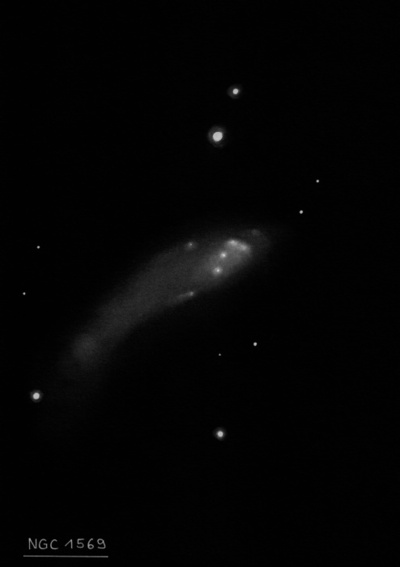
William Herschel discovered NGC 1569 = H II-768 on 4 Nov 1788 (sweep 881) and noted "pB, S, lE, BN, just south of a pretty bright star." Ralph Copeland observed this galaxy on 17 Jan 1873 using Lord Rosse's 72" and recorded, "Decidedly cometic in appearance, with the head north-preceding. Position of elongation 111.2?. Has an 11 mag reddish star in PA 359?, Dist 45". This star is the south member of a double star. There is also a 15m star following in the direction of the axis of the nebula. This object, although of the second class, is 3 or 4x as bright as H I-258 [NGC 1491]."
200/250mm - 8" (11/28/81): fairly bright, small, elongated. Located just south of a mag 9 star.
300/350mm - 13.1" (1/18/85): very bright, elongated 2:1 WNW-ESE, high surface brightness, elongated bright core, mottling suspected. Located just 1' S of a mag 10 star.
400/500mm - 17.5" (3/1/03): at 380x this is a bright, very elongated galaxy with an unusual asymmetric appearance, situated less than 1' S of a mag 9.5 star! Extended nearly 5:2 NW-SE, 2.0'x0.8'. The bright core is offset to the NW side of the glow with a tail extending SE, possibly bending at a slight angle to the core. Two stellar "nuclei" are visible in good seeing. The brighter "star" is embedded within the core, possibly just slightly north of center. A second fainter "star" is close SE, near the edge of the core and is visible intermittently. These "stars" are actually SSC's (luminous super-star clusters). NGC 1569 was recently determined to be a member of the IC 342 galaxy group.
17.5" (1/12/02): very bright, elongated 5:2 WNW-ESE, 2.5'x1.1', high but irregular surface brightness with an asymmetric appearance. The very bright core is mottled and irregular and is offset to the NW side of the galaxy! At 380x, there are two stellar "nuclei" within this glow. The brighter stellar nucleus is fairly easy and a fainter stellar point is close SE. There is also a strong impression of a third stellar spot close west of the central nucleus. These faint "stars" are actually luminous super-star clusters, the most massive known type of star clusters (color image at http://www.lowell.edu/users/dah/papers/n1569hst.html). A mag 10 star is close off the north side, 1' from center and a mag 13 star is just off the SE end.
900/1200mm - 48" (10/23/11): at 488x, three very compact knots (luminous super-star clusters) were closely lined up from NW to SE in the central region (total length ~15") with the brightest knot NGC 1569-A in the middle of the trio. NGC 1569-A was flanked by 1569-C 7" NW and 1569-B 7" SE. NGC 1569-C appeared very small but was also clearly non-stellar. NGC 1569-B, very close to the geometric center, was very compact and symmetrical, like a slightly bloated star. SIMBAD lists a V mag of 15.3 for 1569-A.
Notes by Steve Gottlieb